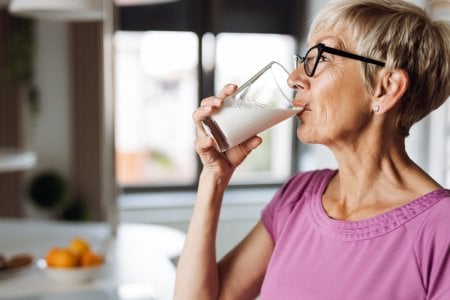Health alert: This 'health drink' trend could be a ‘recipe for disaster’
By
Seia Ibanez
- Replies 10
In the quest for wellness and vitality, many travellers are often on the lookout for the next big health trend.
However, a recent surge in the popularity of a so-called 'health drink' has raised serious concerns among health experts and authorities.
Travellers to the United States, particularly, are being cautioned against indulging in a health food delicacy that poses a significant disease risk: raw milk.
Raw milk, unpasteurised and unprocessed, has been touted by celebrities like Premier League club Manchester City striker Erling Haaland and actress Gwyneth Paltrow.
Fans of the drink claim it offers a range of health benefits, from improved digestion to a stronger immune system.
Despite these endorsements, medical professionals have largely debunked these claims, stressing that consuming raw milk is not only unbeneficial but also 'dangerous’.
The alarm bells have been ringing louder since the detection of a high-pathogenic strain of avian influenza, known as HPAI, in US dairy herds.
In a worrying trend, some individuals have been mistakenly led to believe that drinking raw milk containing the virus could grant them immunity.
This misconception has contributed to a rise in raw milk consumption despite the risks associated with the disease.
Data from NielsenIQ, the world's largest database of consumer buying behaviour, indicated a startling increase in raw milk sales.
In the first week of May, spending on raw milk was 22.5 per cent higher than the same period the previous year.
Following the initial detection of HPAI in US cows on 25 March, the consumption rate soared, with sales in some weeks jumping over 65 per cent compared to 2023 figures.
While milk prices in the US have only increased 1.5 per cent over the past year, NielsenIQ attributed the surge in expenditures to a higher volume of raw milk sales.
Fortunately for public health officials, the amount spent on raw milk remained relatively low—between US $52,000 ($77,000 AUD) and US $60,000 ($89,000 AUD) annually, in stark contrast to the hundreds of millions spent on pasteurised milk.
The International Dairy Foods Association's Senior Vice President of Consumer Affairs, Matt Herrick, has strongly advised against consuming raw milk.
‘Raw milk consumption has always been a recipe for disaster,’ he said.
‘The [US Food and Drug Administration] has been clear for decades that unpasteurised milk is dangerous and should not be consumed by anyone. At the same time, we’re talking about a product that is less than 1 per cent of total milk sales on any given day, so it’s receiving outsized media attention.’
Despite the warnings, some customers continue to purchase raw milk under the misguided belief that it will protect them from avian influenza.
Advocates have dismissed the cautions as 'fearmongering', with the California-based Raw Milk Institute reporting that its customers actively seek out 'H5N1 milk' for its supposed immunity benefits.
Professor Peter Collignon, an Infectious Diseases Expert at Australian National University and Canberra Hospital, has reassured that cattle in Australia are unlikely to contract HPAI.
Oceania remains the only region free of the virus, thanks to stringent animal husbandry regulations that prevent suspected transmission methods, such as feeding poultry waste to cattle.
Over the past two decades, approximately 900 people have been infected with the H5N1 strain of avian influenza, resulting in 460 fatalities.
While the virus has had a devastating impact on other mammal populations, including sea lions and minks, the human infection rate has remained lower than initially feared by some experts.
In pursuit of keeping ourselves healthy, sometimes it turns out for the worst. That’s why it’s crucial to keep an eye out to stay safe from food poisoning.
In a previous story, an ER doctor and trauma surgeon revealed the top three foods he would never eat due to potential food poisoning risks. You can read more about the story here.

Have you ever tried raw milk, or do you know someone who has? What are your views on the balance between natural products and health risks? Share your stories and insights in the comments below!
However, a recent surge in the popularity of a so-called 'health drink' has raised serious concerns among health experts and authorities.
Travellers to the United States, particularly, are being cautioned against indulging in a health food delicacy that poses a significant disease risk: raw milk.
Raw milk, unpasteurised and unprocessed, has been touted by celebrities like Premier League club Manchester City striker Erling Haaland and actress Gwyneth Paltrow.
Fans of the drink claim it offers a range of health benefits, from improved digestion to a stronger immune system.
Despite these endorsements, medical professionals have largely debunked these claims, stressing that consuming raw milk is not only unbeneficial but also 'dangerous’.
The alarm bells have been ringing louder since the detection of a high-pathogenic strain of avian influenza, known as HPAI, in US dairy herds.
In a worrying trend, some individuals have been mistakenly led to believe that drinking raw milk containing the virus could grant them immunity.
This misconception has contributed to a rise in raw milk consumption despite the risks associated with the disease.
Data from NielsenIQ, the world's largest database of consumer buying behaviour, indicated a startling increase in raw milk sales.
In the first week of May, spending on raw milk was 22.5 per cent higher than the same period the previous year.
Following the initial detection of HPAI in US cows on 25 March, the consumption rate soared, with sales in some weeks jumping over 65 per cent compared to 2023 figures.
While milk prices in the US have only increased 1.5 per cent over the past year, NielsenIQ attributed the surge in expenditures to a higher volume of raw milk sales.
Fortunately for public health officials, the amount spent on raw milk remained relatively low—between US $52,000 ($77,000 AUD) and US $60,000 ($89,000 AUD) annually, in stark contrast to the hundreds of millions spent on pasteurised milk.
The International Dairy Foods Association's Senior Vice President of Consumer Affairs, Matt Herrick, has strongly advised against consuming raw milk.
‘Raw milk consumption has always been a recipe for disaster,’ he said.
‘The [US Food and Drug Administration] has been clear for decades that unpasteurised milk is dangerous and should not be consumed by anyone. At the same time, we’re talking about a product that is less than 1 per cent of total milk sales on any given day, so it’s receiving outsized media attention.’
Despite the warnings, some customers continue to purchase raw milk under the misguided belief that it will protect them from avian influenza.
Advocates have dismissed the cautions as 'fearmongering', with the California-based Raw Milk Institute reporting that its customers actively seek out 'H5N1 milk' for its supposed immunity benefits.
Professor Peter Collignon, an Infectious Diseases Expert at Australian National University and Canberra Hospital, has reassured that cattle in Australia are unlikely to contract HPAI.
Oceania remains the only region free of the virus, thanks to stringent animal husbandry regulations that prevent suspected transmission methods, such as feeding poultry waste to cattle.
Over the past two decades, approximately 900 people have been infected with the H5N1 strain of avian influenza, resulting in 460 fatalities.
While the virus has had a devastating impact on other mammal populations, including sea lions and minks, the human infection rate has remained lower than initially feared by some experts.
In pursuit of keeping ourselves healthy, sometimes it turns out for the worst. That’s why it’s crucial to keep an eye out to stay safe from food poisoning.
In a previous story, an ER doctor and trauma surgeon revealed the top three foods he would never eat due to potential food poisoning risks. You can read more about the story here.
Key Takeaways
- Travellers to the United States are being warned about the dangers of consuming raw milk due to the risk of serious diseases.
- Consumption of raw milk has risen despite warnings, with some believing it provides immunity against a high-pathogenic strain of avian influenza.
- Data from NielsenIQ indicated a significant increase in raw milk sales, although it remains a small percentage of total milk sales.
- Health experts and authorities strongly advised against the consumption of raw milk, criticising the practice as dangerous and misguided.









